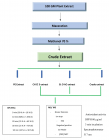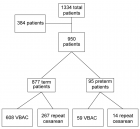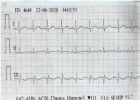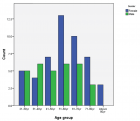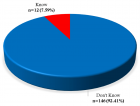Abstract
Research Article
Detection of IDH mutations in cerebrospinal fluid: A discussion of liquid biopsy in neuropathology
Ming Lee*, Gek San Tan, Chee Kian Tham and Kiat-Hon Tony Lim
Published: 17 September, 2020 | Volume 4 - Issue 1 | Pages: 011-023
Isocitrate dehydrogenase (IDH) mutations are a common event in secondary glioblastoma multiforme and lower-grade adult infiltrative astrocytomas and independently confer a better prognosis [1,2]. These are highly conserved mutations during glioma progression and thus also a useful diagnostic marker amenable to modern molecular sequencing methods. These mutations can even be detected in sites distant from the primary tumour. We use an illustrative case of a patient with radiologically suspected recurrent astrocytoma and negative histology, but positive IDH-mutated tumour DNA detected within CSF. Our results demonstrated the usefulness of liquid biopsy for recurrent glioma within the context of equivocal or negative histopathological results, whilst also showing the ability to detect a de-novo IDH-2 mutation not present in the previous resection. Building on this ‘proof-of-concept’ result, we also take the opportunity to briefly review the current literature describing the various liquid biopsy substrates available to diagnose infiltrative gliomas, namely the study of circulating tumour DNA, circulating tumour cells, and extracellular vesicles. We outline the current challenges and prospects of liquid biopsies in these tumours and suggest that more studies are required to overcome these challenges and harness the potential benefits of liquid biopsies in guiding our management of gliomas
Read Full Article HTML DOI: 10.29328/journal.apcr.1001018 Cite this Article Read Full Article PDF
References
- Hartmann C, Hentschel B, Tatagiba M, Schramm J, Schnell O, et al. Molecular Markers in Low-Grade Gliomas: Predictive or Prognostic? Clin Cancer Res. 2011; 17: 4588–4599. Pubmed: http://www.ncbi.nlm.nih.gov/pubmed/21558404
- Reuss DE, Mamatjan Y, Schrimpf D, Capper D, Hovestadt V, et al. IDH mutant diffuse and anaplastic astrocytomas have similar age at presentation and little difference in survival: a grading problem for WHO. Acta Neuropathol. 2015; 129: 867–873. PubMed: https://pubmed.ncbi.nlm.nih.gov/25962792/
- Louis DN, Perry A, Reifenberger G, von Deimling A, Figarella-Branger D, et al. The 2016 World Health Organization Classification of Tumors of the Central Nervous System: a summary. Acta Neuropathol. 2016; 131: 803–820. PubMed: https://pubmed.ncbi.nlm.nih.gov/27157931/
- Sahm F, Schrimpf D, Jones DTW, Meyer J, Kratz A, et al. Next-generation sequencing in routine brain tumor diagnostics enables an integrated diagnosis and identifies actionable targets. Acta Neuropathol. 2016; 131: 903–910. PubMed: https://pubmed.ncbi.nlm.nih.gov/26671409
- Li KW, Ng HK. How does one do next-generation sequencing for brain tumors in the clinical laboratories? Glioma. 2018; 1: 149.
- Kim H, Zheng S, Amini SS, Virk SM, Mikkelsen T, et al. Whole-genome and multisector exome sequencing of primary and post-treatment glioblastoma reveals patterns of tumor evolution. Genome Res. 2015; 25: 316–227. PubMed: https://pubmed.ncbi.nlm.nih.gov/25650244/
- Hartmann C, Hentschel B, Simon M, Westphal M, Schackert G, et al. Long-term survival in primary glioblastoma with versus without isocitrate dehydrogenase mutations. Clin Cancer Res. 2013; 19: 5146–5157. PubMed: https://pubmed.ncbi.nlm.nih.gov/23918605/
- Sanson M, Marie Y, Paris S, Idbaih A, Laffaire J, et al. Isocitrate dehydrogenase 1 codon 132 mutation is an important prognostic biomarker in gliomas. J Clin Oncol. 2009; 27: 4150–4154. PubMed: https://pubmed.ncbi.nlm.nih.gov/19636000/
- Yan H, Williams D, Jin G, Mclendon R, Rasheed BA, et al. IDH1 and IDH2 Mutations in Gliomas. N Engl J Med. 2009; 360: 765–773. PubMed: https://pubmed.ncbi.nlm.nih.gov/19228619/
- Loo HK, Mathen P, Lee J, Camphausen K. Circulating biomarkers for high-grade glioma. Biomark Med. 2019; 13: 161–165. PubMed: https://pubmed.ncbi.nlm.nih.gov/30806515/
- Brat DJ, Verhaak RGW, Aldape KD, Yung WKA, Salama SR, et al. Comprehensive, integrative genomic analysis of diffuse lower-grade gliomas. N Engl J Med. 2015; 372: 2481–2498. PubMed: http://www.nejm.org/doi/10.1056/NEJMoa1402121
- Wang SR, Malik S, Tan IB, Chan YS, Hoi Q, et al. Technical Validation of a Next-Generation Sequencing Assay for Detecting Actionable Mutations in Patients with Gastrointestinal Cancer. J Mol Diagnostics. 2016; 18: 416–424. PubMed: https://pubmed.ncbi.nlm.nih.gov/26970585/
- Horbinski C. What do we know about IDH1/2 mutations so far, and how do we use it? Acta Neuropathol. 2013; 125: 621–636. PubMed: https://pubmed.ncbi.nlm.nih.gov/23512379/
- Kruser TJ, Mehta MP, Robins HI. Pseudoprogression after glioma therapy: A comprehensive review. Expert Rev Neurother. 2013; 13: 389–403. PubMed: https://pubmed.ncbi.nlm.nih.gov/23545054/
- Westphal M, Lamszus K. Circulating biomarkers for gliomas. Nat Rev Neurol. 2015;11: 556–566. PubMed: https://pubmed.ncbi.nlm.nih.gov/26369507/
- Cabel L, Proudhon C, Gortais H, Loirat D, Coussy F, et al. Circulating tumor cells: clinical validity and utility. Int J Clin Oncol. 2017; 22: 421–430. PubMed: https://pubmed.ncbi.nlm.nih.gov/28238187/
- Choon AW T. Clinical Utility of Circulating Tumor Cells – A Clinician’s Current View. Hematol Med Oncol. 2017; 2: 1–9.
- Sottoriva A, Spiteri I, Piccirillo SGM, Touloumis A, Collins VP, et al. Intratumor heterogeneity in human glioblastoma reflects cancer evolutionary dynamics. Proc Natl Acad Sci. 2013; 110: 4009–1014. PubMed: https://www.pnas.org/content/110/10/4009
- MacArthur KM, Kao GD, Chandrasekaran S, Alonso-Basanta M, Chapman C, et al. Detection of brain tumor cells in the peripheral blood by a telomerase promoter-based assay. Cancer Res. 2014; 74: 2152–2159. PubMed: https://pubmed.ncbi.nlm.nih.gov/24525740/
- Kros JM, Mustafa DM, Dekker LJM, Smitt PAES, Luider TM, et al. Circulating glioma biomarkers. Neuro Oncol. 2015; 17: 343–360. PubMed: https://www.ncbi.nlm.nih.gov/pmc/articles/PMC4483097/
- Saenz-Antoñanzas A, Auzmendi-Iriarte J, Carrasco-Garcia E, Moreno-Cugnon L, Ruiz I, et al. Liquid biopsy in glioblastoma: Opportunities, applications and challenges. Cancers (Basel). 2019; 11: 950. PubMed: https://pubmed.ncbi.nlm.nih.gov/31284524/
- Müller Bark J, Kulasinghe A, Chua B, Day BW, Punyadeera C. Circulating biomarkers in patients with glioblastoma. Br J Cancer. 2020; 122: 295-305.. PubMed: https://pubmed.ncbi.nlm.nih.gov/31666668/
- Orlic L, Sladoje-Martinovic B, Mikolasevic I, Zupan Z, Racki S. Patients with primary brain tumors as organ donors. BANTAO J. 2015; 13: 34–38.
- Müller C, Holtschmidt J, Auer M, Heitzer E, Lamszus K, et al. Cancer: Hematogenous dissemination of glioblastoma multiforme. Sci Transl Med. 2014; 6: 247ra101. PubMed: https://pubmed.ncbi.nlm.nih.gov/25080476/
- Jackson D. Rapp HM, Schneiderhan TM, Michael Sabel Anne Hayman Axel SchererPatric Kröpil , Wilfried Budach , Usha Kretschmar , Peter Arne Gerber Sujit Prabhu , Lawrence E. Ginsberg Edwin Bölke CM. Glioblastoma Multiforme Metastasis Outside the CNS: Three Case Reports and Possible Mechanisms of Escape Introduction. J Clin Oncol. 2012; 29: 2011–2013.
- Ferreira MM, Ramani VC, Jeffrey SS. Circulating tumor cell technologies. Mol Oncol. 2016; 10: 374–394. www.nature.com/npjprecisiononcology%0Ahttp://www.nature.com/articles/s41698-017-0028-8
- Lombard A, Goffart N, Rogister B. Glioblastoma circulating cells: Reality, trap or illusion? Stem Cells Int. 2015; 2015. PubMed: https://pubmed.ncbi.nlm.nih.gov/26078762/
- Krol I, Castro-Giner F, Maurer M, Gkountela S, Szczerba BM, et al. Detection of circulating tumour cell clusters in human glioblastoma. Br J Cancer. 2018; 119: 487–491. PubMed: https://pubmed.ncbi.nlm.nih.gov/30065256/
- Piccioni DE, Lanman RB, Nagy RJ, Talasaz A, Pingle SC, et al. Analysis of cell-free circulating tumor DNA in patients with glioblastoma and other primary brain tumors. J Clin Oncol. 2015; 33: 11072–11072. https://ascopubs.org/doi/10.1200/jco.2015.33.15_suppl.11072
- Wang Y, Springer S, Zhang M, McMahon KW, Kinde I, et al. Detection of tumor-derived DNA in cerebrospinal fluid of patients with primary tumors of the brain and spinal cord. Proc Natl Acad Sci. 2015; 112: 9704–9709. PubMed: https://pubmed.ncbi.nlm.nih.gov/26195750/
- Bettegowda C, Sausen M, Leary RJ, Kinde I, Wang Y, et al. Detection of Circulating Tumor DNA in Early- and Late-Stage Human Malignancies. Sci Transl Med. 2014; 62 24ra24-224ra24. http://stm.sciencemag.org/cgi/doi/10.1126/scitranslmed.3007094
- Diehl F, Schmidt K, Choti MA, Romans K, Goodman S, et al. Circulating mutant DNA to assess tumor dynamics. Nat Med. 2008; 14: 985–990. PubMed: https://www.ncbi.nlm.nih.gov/pmc/articles/PMC2820391/ b
- Diaz LA, Bardelli A. Liquid biopsies: Genotyping circulating tumor DNA. J Clin Oncol. 2014; 32: 579–586. PubMed: https://pubmed.ncbi.nlm.nih.gov/24449238/
- Chen WW, Balaj L, Liau LM, Samuels ML, Kotsopoulos SK, et al. Beaming and droplet digital pcr analysis of mutant idh1 mrna in glioma patient serum and cerebrospinal fluid extracellular vesicles. Mol Ther - Nucleic Acids. 2013; 2: e109. PubMed: https://pubmed.ncbi.nlm.nih.gov/23881452/
- Ghosh RK, Pandey T, Dey P. Liquid biopsy: A new avenue in pathology. Cytopathology. 2019; 30: 138–143. PubMed: https://pubmed.ncbi.nlm.nih.gov/30485558/
- Bertero L, Siravegna G, Rudà R, Soffietti R, Bardelli A, et al. Review: Peering through a keyhole: liquid biopsy in primary and metastatic central nervous system tumours. Neuropathol Appl Neurobiol. 2019; 45: 655–670. PubMed: https://pubmed.ncbi.nlm.nih.gov/30977933
- Schwaederle M, Chattopadhyay R, Kato S, Fanta PT, Kimberly C, et al. Genomic alterations in circulating tumor DNA from diverse cancer patients identified by next-generation sequencing. Cancer Res. 2017; 77: 5419–5427. PubMed: https://pubmed.ncbi.nlm.nih.gov/28807936/
- Piccioni DE, Achrol AS, Kiedrowski LA, Banks KC, Boucher N, et al. Analysis of cell-free circulating tumor DNA in 419 patients with glioblastoma and other primary brain tumors. CNS Oncol. 2019; 8: CNS34. PubMed: https://pubmed.ncbi.nlm.nih.gov/30855176/
- Brennan CW, Verhaak RGW, McKenna A, Campos B, Noushmehr H, et al. The Somatic Genomic Landscape of Glioblastoma. Cell. 2013; 155: 462–477. https://linkinghub.elsevier.com/retrieve/pii/S0092867413012087
- WANG Z, JIANG W, WANG Y, GUO Y, CONG Z, et al. MGMT promoter methylation in serum and cerebrospinal fluid as a tumor-specific biomarker of glioma. Biomed Reports. 2015; 3: 543–548. PubMed: https://pubmed.ncbi.nlm.nih.gov/26171163/
- De Mattos-Arruda L, Mayor R, Ng CKY, Weigelt B, Martínez-Ricarte F, et al. Cerebrospinal fluid-derived circulating tumour DNA better represents the genomic alterations of brain tumours than plasma. Nat Commun. 2015; 6: 8839. PubMed: https://pubmed.ncbi.nlm.nih.gov/26554728/
- Miller AM, Shah RH, Pentsova EI, Pourmaleki M, Briggs S, et al. Tracking tumour evolution in glioma through liquid biopsies of cerebrospinal fluid. Nature. 2019; 565: 654–658. PubMed: https://pubmed.ncbi.nlm.nih.gov/30675060/
- Li I, Nabet BY. Exosomes in the tumor microenvironment as mediators of cancer therapy resistance. Mol Cancer. 2019; 18: 32. PubMed: https://pubmed.ncbi.nlm.nih.gov/30823926/
- Skog J, Würdinger T, van Rijn S, Meijer DH, Gainche L, et al. Glioblastoma microvesicles transport RNA and proteins that promote tumour growth and provide diagnostic biomarkers. Nat Cell Biol. 2008; 10: 1470–1476. PubMed: https://pubmed.ncbi.nlm.nih.gov/19011622/
- Shao H, Chung J, Balaj L, Charest A, Bigner DD, et al. Protein typing of circulating microvesicles allows real-time monitoring of glioblastoma therapy. Nat Med. 2012; 18: 1835–1840. http://www.nature.com/articles/nm.2994
- Banelli B, Forlani A, Allemanni G, Morabito A, Pistillo MP, et al. MicroRNA in glioblastoma: An overview. Int J Genomics. 2017; 2017: 7639084. PubMed: https://pubmed.ncbi.nlm.nih.gov/29234674/
- Bader AG, Brown D, Winkler M. The Promise of MicroRNA Replacement Therapy. Cancer Res. 2010; 70: 7027–7030. PubMed: https://pubmed.ncbi.nlm.nih.gov/20807816/
- Li CCY, Eaton SA, Young PE, Lee M, Shuttleworth R, et al. Glioma microvesicles carry selectively packaged coding and noncoding RNAs which alter gene expression in recipient cells. RNA Biol. 2013; 10: 1333–1344. PubMed: https://pubmed.ncbi.nlm.nih.gov/23807490/
- Shi R, Wang PY, Li XY, Chen JX, Li Y, et al. Exosomal levels of miRNA-21 from cerebrospinal fluids associated with poor prognosis and tumor recurrence of glioma patients. Oncotarget. 2015; 6: 26971–26981. PubMed: https://pubmed.ncbi.nlm.nih.gov/26284486/
- Qu S, Guan J, Liu Y. Identification of microRNAs as novel biomarkers for glioma detection: A meta-analysis based on 11 articles. J Neurol Sci. 2015; 348: 181–187. PubMed: https://pubmed.ncbi.nlm.nih.gov/25510379/
- Zhang W, Zhang J, Hoadley K, Kushwaha D, Ramakrishnan V, et al. MiR-181d: Predictive glioblastoma biomarker that downregulates MGMT expression. Neuro Oncol. 2012; 14: 712–719. PubMed: https://pubmed.ncbi.nlm.nih.gov/22570426/
- Verbeek B, Southgate TD, Gilham DE, Margison GP. O6-Methylguanine-DNA methyltransferase inactivation and chemotherapy. Br Med Bull. 2008; 85: 17–33. PubMed: https://pubmed.ncbi.nlm.nih.gov/18245773/
- Tang K, Gardner S, Snuderl M. The Role of Liquid Biopsies in Pediatric Brain Tumors. J Neuropathol Exp Neurol. 2020; 79: 934-940. PubMed: https://pubmed.ncbi.nlm.nih.gov/32766689/
- Tuxen MK, Sölétormos G, Dombernowsky P. Serum tumour marker CA 125 in monitoring of ovarian cancer during first-line chemotherapy. Br J Cancer. 2001; 84: 1301–1307. PubMed: https://pubmed.ncbi.nlm.nih.gov/11355938/
- Ito K, Hibi K, Ando H, Hidemura K, Yamazaki T, et al. Usefulness of analytical CEA doubling time and half-life time for overlooked synchronous metastases in colorectal carcinoma. Jpn J Clin Oncol. 2002; 32: 54–58. PubMed: https://pubmed.ncbi.nlm.nih.gov/11948229/
- Shinozaki M, O’Day SJ, Kitago M, Amersi F, Kuo C, et al. Utility of circulating B-RAF DNA mutation in serum for monitoring melanoma patients receiving biochemotherapy. Clin Cancer Res. 2007; 13: 2068–2074. PubMed: https://pubmed.ncbi.nlm.nih.gov/17404088/
- Dawson SJ, Tsui DWY, Murtaza M, Biggs H, Rueda OM, et al. Analysis of circulating tumor DNA to monitor metastatic breast cancer. N Engl J Med. 2013; 368: 1199–1209. PubMed: https://pubmed.ncbi.nlm.nih.gov/23484797/
- Thomsen CEB, Appelt AL, Andersen RF, Lindebjerg J, Jensen LH, et al. The prognostic value of simultaneous tumor and serum RAS/RAF mutations in localized colon cancer. Cancer Med. 2017; 6: 928–936. PubMed: https://pubmed.ncbi.nlm.nih.gov/28378527/
- Rudà R, Reifenberger G, Frappaz D, Pfister SM, Laprie A, et al. EANO guidelines for the diagnosis and treatment of ependymal tumors. Neuro Oncol. 2018; 20: 445–456. PubMed: https://pubmed.ncbi.nlm.nih.gov/29194500/
- Sharma P, Hu-Lieskovan S, Wargo JA, Ribas A. Primary, Adaptive, and Acquired Resistance to Cancer Immunotherapy. Cell. 2017; 168: 707–723. PubMed: https://pubmed.ncbi.nlm.nih.gov/28187290/
- Misale S, Yaeger R, Hobor S, Scala E, Janakiraman M, et al. Emergence of KRAS mutations and acquired resistance to anti-EGFR therapy in colorectal cancer. Nature. 2012; 486: 532–536. PubMed: https://pubmed.ncbi.nlm.nih.gov/22722830/
- Camidge DR, Pao W, Sequist LV. Acquired resistance to TKIs in solid tumours: Learning from lung cancer. Nat Rev Clin Oncol. 2014; 11: 473–481. PubMed: https://pubmed.ncbi.nlm.nih.gov/24981256/
- Serrano C, George S, Valverde C, Olivares D, García-Valverde A, et al. Novel Insights into the Treatment of Imatinib-Resistant Gastrointestinal Stromal Tumors. Target Oncol. 2017; 12: 277–288. PubMed: https://pubmed.ncbi.nlm.nih.gov/28478525/
- Murtaza M, Dawson SJ, Tsui DWY, Gale D, Forshew T, et al. Non-invasive analysis of acquired resistance to cancer therapy by sequencing of plasma DNA. Nature. 2013; 497: 108–112. PubMed: https://pubmed.ncbi.nlm.nih.gov/23563269/
- Higgins MJ, Jelovac D, Barnathan E, Blair B, Slater S, et al. Detection of tumor PIK3CA status in metastatic breast cancer using peripheral blood. Clin Cancer Res. 2012; 18: 3462–3469. PubMed: https://pubmed.ncbi.nlm.nih.gov/22421194/
- Akers JC, Ramakrishnan V, Yang I, Hua W, Mao Y, et al. Optimizing preservation of extracellular vesicular miRNAs derived from clinical cerebrospinal fluid. Cancer Biomarkers. 2016; 17: 125–132. PubMed: https://pubmed.ncbi.nlm.nih.gov/27062568/
- Fritz JV, Heintz-Buschart A, Ghosal A, Wampach L, Etheridge A, et al. Sources and Functions of Extracellular Small RNAs in Human Circulation. Annu Rev Nutr. 2016; 36: 301–336. PubMed: https://pubmed.ncbi.nlm.nih.gov/27215587/
- Akers JC, Ramakrishnan V, Nolan JP, Duggan E, Fu CC, et al. Comparative analysis of technologies for quantifying extracellular vesicles (EVs) in clinical cerebrospinal fluids (CSF). PLoS One. 2016; 11: e0149866. PubMed: https://pubmed.ncbi.nlm.nih.gov/26901428/
- Gao F, Cui Y, Jiang H, Sui D, Wang Y, et al. Circulating tumor cell is a common property of brain glioma and promotes the monitoring system. Oncotarget. 2016; 7: 71330–71340. PubMed: https://pubmed.ncbi.nlm.nih.gov/27517490/
- Kros JM, Huizer K, Hernández-Laín A, Marucci G, Michotte A, et al. Evidence-based diagnostic algorithm for glioma: Analysis of the results of pathology panel review and molecular parameters of EORTC 26951 and 26882 trials. J Clin Oncol. 2015; 33: 1943–1950. PubMed: https://pubmed.ncbi.nlm.nih.gov/25918297/
Figures:
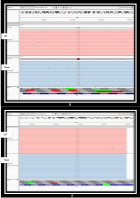
Figure 1

Figure 2
Similar Articles
-
Role of Carcinoma Associated Fibroblasts in Anoikis Resistance in Oral Squamous Cell Carcinoma –need of the hourAnjali Ganjre*. Role of Carcinoma Associated Fibroblasts in Anoikis Resistance in Oral Squamous Cell Carcinoma –need of the hour. . 2017 doi: 10.29328/journal.hjpcr.1001001; 1: 001-004
-
Hypernatremia and central Diabetes Insipidus following Neurosurgical procedure of TraumaAwad Magbri*,Eussera El-Magbri,Seth Hershit. Hypernatremia and central Diabetes Insipidus following Neurosurgical procedure of Trauma . . 2017 doi: 10.29328/journal.hjpcr.1001002; 1: 005-008
-
MicroRNA Therapeutics in Triple Negative Breast CancerSarmistha Mitra*. MicroRNA Therapeutics in Triple Negative Breast Cancer . . 2017 doi: 10.29328/journal.hjpcr.1001003; 1: 009-017
-
A great mimicker of Bone Secondaries: Brown Tumors, presenting with a Degenerative Lumber Disc like painZuhal Bayramoglu*,Ravza Yılmaz,Aysel Bayram. A great mimicker of Bone Secondaries: Brown Tumors, presenting with a Degenerative Lumber Disc like pain. . 2017 doi: 10.29328/journal.hjpcr.1001004; 1: 018-023
-
Predicament of classification: Multisystem small vessel vasculitis with cresentic GlomerulonephritisAwad Magbri*,Shaukat Rashid,Balhinder Brar . Predicament of classification: Multisystem small vessel vasculitis with cresentic Glomerulonephritis. . 2018 doi: 10.29328/journal.apcr.1001005; 2: 001-005
-
Pathological Effects of Cypermethrin on the Testes and Accessory Sexual Glands of Yankasa RamsUbah Simon*,Ogwu David,Rekwot Peter, Rwuaan Joseph,Chibuogwu Ijeoma, Njoku Celestine. Pathological Effects of Cypermethrin on the Testes and Accessory Sexual Glands of Yankasa Rams. . 2018 doi: 10.29328/journal.apcr.1001006; 2: 006-012
-
In at the deep end: Psychosocial aspects of developing autonomy in histopathology trainingAI Finall*. In at the deep end: Psychosocial aspects of developing autonomy in histopathology training. . 2018 doi: 10.29328/journal.apcr.1001007; 2: 013-019
-
Histological clonal change - A feature for dysplasia diagnosisLewei Zhang*,Tarinee Lubpairee,Denise M Laronde1, Martial Guillaud, Calum E MacAulay,Miriam P Rosin. Histological clonal change - A feature for dysplasia diagnosis. . 2018 doi: 10.29328/journal.apcr.1001008; 2: 020-028
-
Amyotropyc Lateral Sclerosis and Endogenous -Esogenous Toxicological Movens: New model to verify other Pharmacological StrategiesMauro Luisetto*,Behzad Nili-Ahmadabadi,Nilesh M Meghani,Ghulam Rasool Mashori,Ram Kumar Sahu,Kausar Rehman Khan, Ahmed Yesvi Rafa,Luca Cabianca,Gamal Abdul Hamid, Farhan Ahmad Khan. Amyotropyc Lateral Sclerosis and Endogenous -Esogenous Toxicological Movens: New model to verify other Pharmacological Strategies. . 2018 doi: 10.29328/journal.apcr.1001009; 2: 029-048
-
Receptor pharmacology and other relevant factors in lower urinary tract pathology under a functional and toxicological approach: Instrument to better manage antimicrobials therapyMauro Luisetto*,Naseer Almukhtar,Behzad Nili-Ahmadabadi,Ghulam Rasool Mashori,Kausar Rehman Khan,Ram Kumar Sahu,Farhan Ahmad Khan,Gamal Abdul Hamid,Luca Cabianca. Receptor pharmacology and other relevant factors in lower urinary tract pathology under a functional and toxicological approach: Instrument to better manage antimicrobials therapy . . 2018 doi: 10.29328/journal.apcr.1001010; 2: 049-093
Recently Viewed
-
Outpatient operative hysteroscopy: evaluation of patient satisfaction and acceptanceClare Margaret Crowley*,Noelle Gill,Minna Geisler. Outpatient operative hysteroscopy: evaluation of patient satisfaction and acceptance. Clin J Obstet Gynecol. 2022: doi: 10.29328/journal.cjog.1001098; 5: 005-008
-
Predictors of positive treatment response to PTNS in women with overactive bladderSuneetha Rachaneni*,Doyo Enki,Megan Welstand,Thomasin Heggie,Anupreet Dua. Predictors of positive treatment response to PTNS in women with overactive bladder. Clin J Obstet Gynecol. 2022: doi: 10.29328/journal.cjog.1001097; 5: 001-004
-
Prediction of neonatal and maternal index based on development and population indicators: a global ecological studySedigheh Abdollahpour,Hamid Heidarian Miri,Talat Khadivzadeh*. Prediction of neonatal and maternal index based on development and population indicators: a global ecological study. Clin J Obstet Gynecol. 2021: doi: 10.29328/journal.cjog.1001096; 4: 101-105
-
A Genetic study in assisted reproduction and the risk of congenital anomaliesKaparelioti Chrysoula,Koniari Eleni*,Efthymiou Vasiliki,Loutradis Dimitrios,Chrousos George,Fryssira Eleni. A Genetic study in assisted reproduction and the risk of congenital anomalies. Clin J Obstet Gynecol. 2021: doi: 10.29328/journal.cjog.1001095; 4: 096-100
-
Leiomyosarcoma in pregnancy: Incidental finding during routine caesarean sectionToon Wen Tang*,Phoon Wai Leng Jessie. Leiomyosarcoma in pregnancy: Incidental finding during routine caesarean section. Clin J Obstet Gynecol. 2021: doi: 10.29328/journal.cjog.1001094; 4: 092-095
Most Viewed
-
Evaluation of Biostimulants Based on Recovered Protein Hydrolysates from Animal By-products as Plant Growth EnhancersH Pérez-Aguilar*, M Lacruz-Asaro, F Arán-Ais. Evaluation of Biostimulants Based on Recovered Protein Hydrolysates from Animal By-products as Plant Growth Enhancers. J Plant Sci Phytopathol. 2023 doi: 10.29328/journal.jpsp.1001104; 7: 042-047
-
Sinonasal Myxoma Extending into the Orbit in a 4-Year Old: A Case PresentationJulian A Purrinos*, Ramzi Younis. Sinonasal Myxoma Extending into the Orbit in a 4-Year Old: A Case Presentation. Arch Case Rep. 2024 doi: 10.29328/journal.acr.1001099; 8: 075-077
-
Feasibility study of magnetic sensing for detecting single-neuron action potentialsDenis Tonini,Kai Wu,Renata Saha,Jian-Ping Wang*. Feasibility study of magnetic sensing for detecting single-neuron action potentials. Ann Biomed Sci Eng. 2022 doi: 10.29328/journal.abse.1001018; 6: 019-029
-
Pediatric Dysgerminoma: Unveiling a Rare Ovarian TumorFaten Limaiem*, Khalil Saffar, Ahmed Halouani. Pediatric Dysgerminoma: Unveiling a Rare Ovarian Tumor. Arch Case Rep. 2024 doi: 10.29328/journal.acr.1001087; 8: 010-013
-
Physical activity can change the physiological and psychological circumstances during COVID-19 pandemic: A narrative reviewKhashayar Maroufi*. Physical activity can change the physiological and psychological circumstances during COVID-19 pandemic: A narrative review. J Sports Med Ther. 2021 doi: 10.29328/journal.jsmt.1001051; 6: 001-007

HSPI: We're glad you're here. Please click "create a new Query" if you are a new visitor to our website and need further information from us.
If you are already a member of our network and need to keep track of any developments regarding a question you have already submitted, click "take me to my Query."






